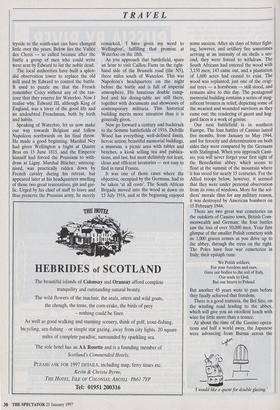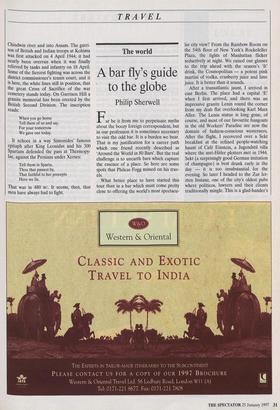Battlefields
We will remember them
Stuart Campbell
Taking part in battle puts a man into a very special category. He sheds his mantle of the humdrum and civilised life as he takes up weapons, and most of his scruples about killing or wounding another human being are set aside in favour of a group conscience. Great battlefields retain a genius loci. When we visit them, we visit places that forged our modern conscious- ness; scenes of collective struggle which changed the destinies of mankind.
From 1066 to 1815, we fought no fewer than 32 pitched battles against the French; so it is fit to start with an action that took place six and a half centuries ago — the battle of Crecy. After his troops had com- mitted arson, pillage and rape across the Norman countryside, Edward III of Eng- land managed to place his army, thorough- ly rested and fed, on the high ground to await the army of Philip VI of France. It was 26 August 1346, and the engagement began in mid-afternoon. The French mounted knights were destroyed by the English longbowmen, losing 1,542 of their number together with some 10,000 'other ranks'.
If you walk out of Crecy village up the minor road (the D111) you are on Edward's ridge. The broad sweep of coun-
TRAVEL
tryside to the south-east can have changed little over the years. Below lies the Vallee des Clercs — so called because after the battle a group of men who could write were sent by Edward to list the noble dead.
The local authorities have built a splen- did observation tower to replace the old mill used by Edward to control the battle. It used to puzzle me that the French remember Crecy without any of the ran- cour that they reserve for Waterloo. Now I realise why. Edward III, although King of England, was a lover of the good life and an undoubted Frenchman, both by birth and habits.
Speaking of Waterloo, let us now make our way towards Belgium and follow Napoleon northwards on his final throw. He made a good beginning. Marshal Ney had given Wellington a fright at Quatre Bras on 15 June 1815, and the Emperor himself had forced the Prussians to with- draw at Ligny. Marshal Blucher, unrecog- nised, was practically ridden down by French cavalry during his retreat, but appeared later at his headquarters smelling of those two great restoratives, gin and gar- lic. Urged by his chief of staff to leave and thus preserve the Prussian army, he merely remarked, 'I have given my word to Wellington', fulfilling that promise at Waterloo on the 18th.
As you approach that battlefield, spare an hour to visit Caillou Farm on the right- hand side of the Brussels road (the N5), three miles south of Waterloo. This was Napoleon's headquarters on the night before the battle and is full of imperial atmosphere. His luxurious double camp- bed and his dining-table are still there, together with documents and showcases of contemporary militaria. This historical building merits more attention than it is generally given.
Now go forward a century and backtrack to the Somme battlefields of 1916. Delville Wood has everything: well-defined limits, heroic action, beautiful memorial buildings, a museum, a picnic area with tables and benches, a kiosk selling tea and publica- tions, and last, but most definitely not least, clean and efficient lavatories — not easy to find in rural France.
It was one of those cases where the objective, occupied by the Germans, had to be taken 'at all costs'. The South African Brigade moved into the wood at dawn on 15 July 1916, and at the beginning enjoyed some success. After six days of bitter fight- ing, however, and artillery fire sometimes arriving at an intensity of six shells a sec- ond, they were forced to withdraw. The South Africans had entered the wood with 3,150 men; 143 came out, and a plantation of 1,600 acres had ceased to exist. The wood was replanted; just one of the origi- nal trees — a hornbeam — still stood, and remains alive to this day. The pentagonal memorial building contains a series of mag- nificent bronzes in relief, depicting some of the wearied and wounded survivors as they came out; the rendering of gaunt and hag- gard faces is a work of genius.
Our next battlefield is in southern Europe. The four battles of Cassino lasted five months, from January to May 1944, and for ferocity and determination on both sides they were compared by the Germans with Stalingrad. When you approach Cassi- no, you will never forget your first sight of the Benedictine abbey, which seems to float at the summit of the mountain where it has stood for nearly 15 centuries. For the Allied troops below, however, it seemed that they were under personal observation from its rows of windows. More for the sol- diers' morale than for any military reason, it was destroyed by American bombers on 15 February 1944.
There are two great war cemeteries on the outskirts of Cassino town, British Com- monwealth and German; the four battles saw the loss of over 50,000 men. Your first glimpse of the smaller Polish cemetery with its 1,000 graves comes as you drive up to the abbey, through the trees on the right. The Poles have four war cemeteries in Italy; their epitaph runs:
We Polish soldiers, For your freedom and ours, Gave our bodies to the soil of Italy, Our souls to God, But our hearts to Poland.
But another 45 years were to pass before they finally achieved that freedom.
There is a good trattoria, the Bel Sito, on the winding road leading to the abbey, which will give you an excellent lunch with wine for little more than a tenner.
At about the time of the Cassino opera- tions and half a world away, the Japanese were advancing from Burma across the I would like a quote for double glazing.'
TRAVEL
Chindwin river and into Assam. The garri- son of British and Indian troops at Kohima was first attacked on 4 April 1944; it had nearly been overrun when it was finally relieved by tanks and infantry on 18 April. Some of the fiercest fighting was across the district commissioner's tennis court, and it Is here, the white lines still in position, that the great Cross of Sacrifice of the war cemetery stands today. On Garrison Hill a granite memorial has been erected by the British Second Division. The inscription reads:
When you go home Tell them of us and say, For your tomorrow We gave our today.
It echoes in a way Simonides' famous epitaph after King Leonidas and his 300 Spartans defended the pass at Thermopy- lae, against the Persians under Xerxes:
Tell them in Sparta, Thou that passest by, That faithful to her precepts Here we lie.
That was in 480 BC. It seems, then, that men have always had to fight.




































































 Previous page
Previous page